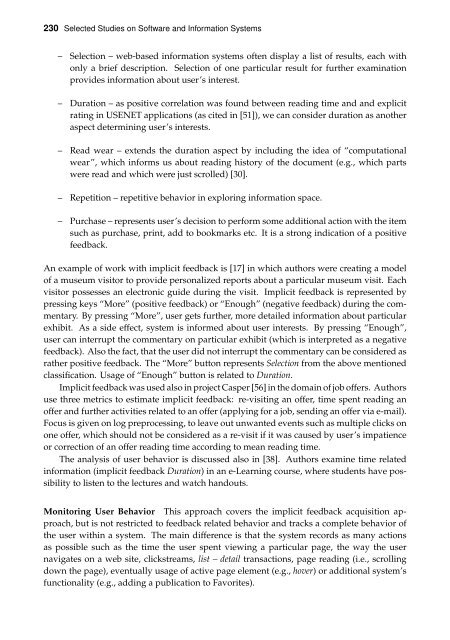elektronická verzia publikácie - FIIT STU - Slovenská technická ...
elektronická verzia publikácie - FIIT STU - Slovenská technická ...
elektronická verzia publikácie - FIIT STU - Slovenská technická ...
You also want an ePaper? Increase the reach of your titles
YUMPU automatically turns print PDFs into web optimized ePapers that Google loves.
230 Selected Studies on Software and Information Systems<br />
– Selection – web-based information systems often display a list of results, each with<br />
only a brief description. Selection of one particular result for further examination<br />
provides information about user’s interest.<br />
– Duration – as positive correlation was found between reading time and and explicit<br />
rating in USENET applications (as cited in [51]), we can consider duration as another<br />
aspect determining user’s interests.<br />
– Read wear – extends the duration aspect by including the idea of “computational<br />
wear”, which informs us about reading history of the document (e.g., which parts<br />
were read and which were just scrolled) [30].<br />
– Repetition – repetitive behavior in exploring information space.<br />
– Purchase – represents user’s decision to perform some additional action with the item<br />
such as purchase, print, add to bookmarks etc. It is a strong indication of a positive<br />
feedback.<br />
An example of work with implicit feedback is [17] in which authors were creating a model<br />
of a museum visitor to provide personalized reports about a particular museum visit. Each<br />
visitor possesses an electronic guide during the visit. Implicit feedback is represented by<br />
pressing keys “More” (positive feedback) or “Enough” (negative feedback) during the commentary.<br />
By pressing “More”, user gets further, more detailed information about particular<br />
exhibit. As a side effect, system is informed about user interests. By pressing “Enough”,<br />
user can interrupt the commentary on particular exhibit (which is interpreted as a negative<br />
feedback). Also the fact, that the user did not interrupt the commentary can be considered as<br />
rather positive feedback. The “More” button represents Selection from the above mentioned<br />
classification. Usage of “Enough” button is related to Duration.<br />
Implicit feedback was used also in project Casper [56] in the domain of job offers. Authors<br />
use three metrics to estimate implicit feedback: re-visiting an offer, time spent reading an<br />
offer and further activities related to an offer (applying for a job, sending an offer via e-mail).<br />
Focus is given on log preprocessing, to leave out unwanted events such as multiple clicks on<br />
one offer, which should not be considered as a re-visit if it was caused by user’s impatience<br />
or correction of an offer reading time according to mean reading time.<br />
The analysis of user behavior is discussed also in [38]. Authors examine time related<br />
information (implicit feedback Duration) in an e-Learning course, where students have possibility<br />
to listen to the lectures and watch handouts.<br />
Monitoring User Behavior This approach covers the implicit feedback acquisition approach,<br />
but is not restricted to feedback related behavior and tracks a complete behavior of<br />
the user within a system. The main difference is that the system records as many actions<br />
as possible such as the time the user spent viewing a particular page, the way the user<br />
navigates on a web site, clickstreams, list – detail transactions, page reading (i.e., scrolling<br />
down the page), eventually usage of active page element (e.g., hover) or additional system’s<br />
functionality (e.g., adding a publication to Favorites).

















